SS Werra: A German Ocean Liner's Journey Through Prestige, Passengers, and the Pages of Maritime History
📌 Explore the SS Werra archival collection at GG Archives—featuring passenger lists, menus, ship fittings, and rare brochures from the North German Lloyd’s elegant transatlantic liner. A trove for educators, students, genealogists, and maritime historians alike.
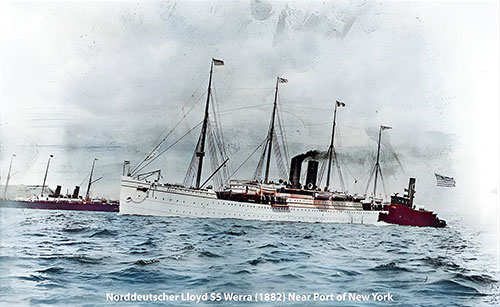
The SS Werra (1882) of the Norddeutscher Lloyd Closing In to Their Pier at Hoboken, NJ, Near the Port of New York. Photo by John S. Johnston. Published by the Detroit Publishing Company ca 1890. Library of Congress LCN 2016805799. | GGA Image ID # 1dcce37339
📖 Introduction: A Steamship That Carried More Than People—It Carried Eras
The SS Werra (1882), a proud vessel of the Norddeutscher Lloyd (NDL) fleet, represents the golden age of transatlantic steamship travel. More than just a ship, it was a mobile cultural crossroads, carrying diplomats, musicians, emigrants, and tourists from the Old World to the New.
Constructed in Scotland by John Elder & Co., the Werra was one of nine sleek "express steamers" that catapulted NDL into prestige among European carriers. Her voyages from Bremen to New York and later from Naples and Genoa via Gibraltar reveal a vessel both luxurious and utilitarian, serving everyone from aristocrats to emigrants.
Content Links
- 📖 Introduction: A Steamship That Carried More Than People—It Carried Eras
- Werra (1882) North German Lloyd Ship's History (Brief)
- Werra (1922) North German Lloyd Ship's History (Brief)
- Passenger Lists
- Brochures
- Passage Contracts, Tickets, and Receipts
- Menus
- Senior Officers and Staff
- Back Cover Images
- Books Referencing the SS Werra
- The Fittings of a Passenger Steamer - 1882
- Salvage of the SS Werra in 1886
- 🌟 Most Engaging Content Highlights
- 📔 Diary of a Voyage on the SS Werra (1894) – A Heartfelt Narrative
- 🍽️ Menus (1900) – Cuisine on the High Seas
- 🛏️ Ship Fittings (1882) – Maritime Luxury Meets Function
- ⚠️ Salvage of the SS Werra (1886) – A Case Study in Maritime Law
- 🖼️ Noteworthy Images
- 📚 Relevance to Researchers, Educators, and the Curious
- ✍️ Final Thoughts – Why This Archival Collection Matters
Werra (1882) North German Lloyd
Built by John Elder & Co., Glasgow, Scotland. Tonnage: 5,109. Dimensions: 438' x 46' (455' o.l.). Single-screw, 17 knots. Compound engines. 6,400 I.H.P. Four masts and two funnels. Iron hull. Passengers: 125 first, 130 second, 1,000 third. Maiden voyage: Bremen-Southampton-New York in October 1882. Transferred to Mediterranean-New York route in 1891. Fate: Sold to Italian shipbreakers in September 1901. Broken up at Genoa in 1903. Sister ship: Fulda. Similar to the Elbe. Note: These passenger ships were of a group of nine express liners built in Scotland for the North German Lloyd. They did much towards giving the line a mark of prestige, which the North German Lloyd has maintained through the years that followed.
Werra (1922) North German Lloyd
Built by Akt. Ges. "Weser", Bremen, Germany. Tonnage: 9,476. Dimensions: 458' x 57'. Triple expansion engines. Two masts and one funnel. Vessel was sold to Italy in August 1935. Renamed: Calabria (1935). Fate: Torpedoed and sunk by submarine, December 8, 1940. Sister ships: Coblenz, Fulda, Saarbrücken and Trier.
Return to Content Links
Passenger Lists
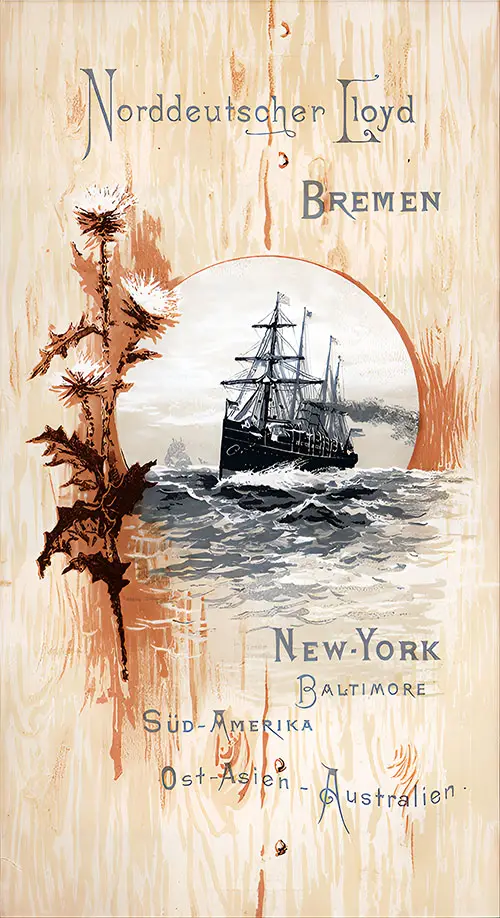
1890-05-03 SS Werra Passenger List
SS Werra Passenger List – A Voyage of Diplomats, Artists, and Dreamers (3 May 1890)
Steamship Line: Norddeutscher Lloyd (North German Lloyd)
Class of Passengers: Cabin
Date of Departure: 3 May 1890
Route: Bremen for New York
Commander: Captain Richard Bussius
The SS Werra, operated by Norddeutscher Lloyd, was launched in 1882 as part of a new class of express steamers designed to serve the bustling Bremen–Southampton–New York route. With an elegant profile, four decks, and robust German engineering, the Werra could carry hundreds across the Atlantic at speeds nearing 16–17 knots. She embodied the shift from mass emigration vessels to more comfortable, modern liners catering to professionals, merchants, and cosmopolitan elites.
🗓️ Voyage Date: 3 May 1890
📍 Route: Bremen ➡ Southampton ➡ New York
👨✈️ Commander: Captain Richard Bussius
This voyage, just before the height of the Ellis Island immigration period, captures a unique cross-section of global society—from Austrian composers and military officers to American businesspeople and Viennese intelligentsia.

1894-12-14 SS Werra Passenger List
Italian Diplomats, Cultural Travelers, and a Winter Crossing to New York (Dec 1894)
Steamship Line: Norddeutscher Lloyd (North German Lloyd)
Class of Passengers: Cabin
Date of Departure: 14 December 1894
Route: Naples to New York via Gibraltar
Commander: Captain G. Pohle
🚢 The SS Werra – A Maritime Classic of North German Lloyd
Built in 1882 for the Norddeutscher Lloyd (NDL) line, the SS Werra was part of a fleet of elegant and dependable express steamers. With her graceful lines and powerful single-screw propulsion, she represented the pinnacle of German engineering and transatlantic service in the late 19th century.
- Launched: 1882
- Operator: Norddeutscher Lloyd (NDL), Bremen
- Route for this Voyage: Naples → Gibraltar → New York
- Departure Date: Friday, 14 December 1894
- Commanded by: Captain G. Pohle
This winter voyage reflected NDL’s growing presence in the Mediterranean emigrant and diplomatic markets, linking Southern Europe and the United States through warmer ports like Naples and Gibraltar during the off-season for North Sea departures.

1896-11-19 SS Werra Passenger List
A Winter Voyage of Diplomats, Divines, and Distinguished Travelers, Enhanced With Insights From the 1894 Diary.
Steamship Line: Norddeutscher Lloyd (North German Lloyd)
Class of Passengers: Cabin
Date of Departure: 19 November 1896
Route: Genoa for New York via Gibraltar
Commander: Captain C. Pohle
Includes: Diary of a Voyage on the SS Werra, 1894
The North German Lloyd steamship SS Werra set sail from Genoa on Thursday, 19 November 1896, bound for New York via Gibraltar. Under the command of Captain C. Pohle, this elegant express liner carried a diverse complement of passengers—Italian emigrants, returning American citizens, religious leaders, and travelers seeking opportunity or reunion across the Atlantic. The passenger list, combined with reflections from the 1894 "Diary of a Voyage on the SS Werra," adds rare emotional texture to the documented journey.
Return to Content Links
Brochures

North German Lloyd - Short Route to London - 1889
🎓 “A 19th-Century Ocean Travel Brochure Turned Educational Goldmine”
The 1889 North German Lloyd (NDL) brochure titled "The Short Route to London via Southampton and the Continent" is more than a promotional travel pamphlet—it is a remarkable cultural artifact that opens a window into late 19th-century transatlantic steamship travel. Created during the Paris Exhibition of 1889, this richly detailed guide was distributed by Oelrichs & Co., the line’s New York agents, and served as both a functional passenger handbook and a marketing showcase for NDL’s first and second cabin services.
Teachers, students, genealogists, and historians will find the brochure incredibly valuable for understanding the social, economic, and technological structures of the Gilded Age’s oceanic travel system.
Return to Content Links
Route Maps, Track Charts, Abstract of Logs
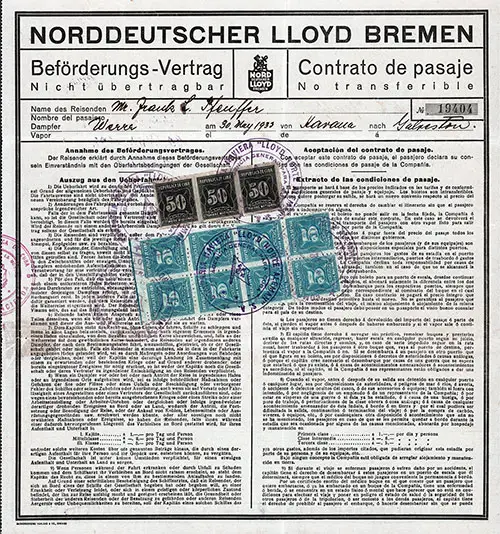
Crossroads in the Caribbean: SS Werra Passage Contract from Havana to Galveston, 1933
The SS Werra Passage Contract from 30 May 1933 is a rare and compelling artifact from the interwar years, illustrating the mechanics and perils of transnational maritime travel in the early 20th century. Issued by Norddeutscher Lloyd Bremen, this contract for Mr. Frauk L. Pfeuffer’s voyage from Havana, Cuba to Galveston, Texas reflects not only the passenger logistics of the time but also the layers of political and legal complexity travelers faced.
Return to Content Links
Menus
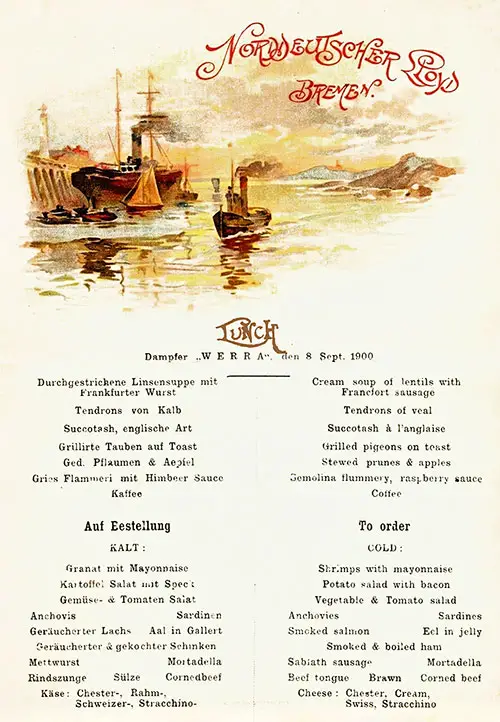
1900-09-08 SS Werra Luncheon Menu Card
From Pigeon to Pâté: A Cosmopolitan Midday Meal Aboard the SS Werra
Aboard the SS Werra of the Norddeutscher Lloyd on Saturday, 8 September 1900, guests were treated to a mid-day meal reflecting both Germanic heartiness and cosmopolitan refinement. The selection and variety suggest Second Cabin service—substantial yet not extravagant, aiming to satisfy middle-class travelers seeking a blend of comfort, quality, and familiarity as they crossed the Atlantic.
Senior Officers and Staff
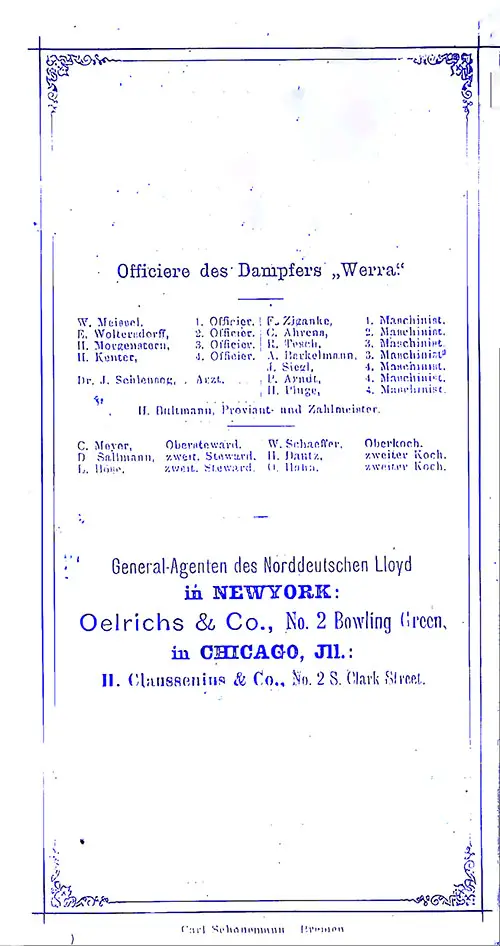
List of Officers, SS Werra Passenger List, 3 May 1890. | GGA Image ID # 213db98a33
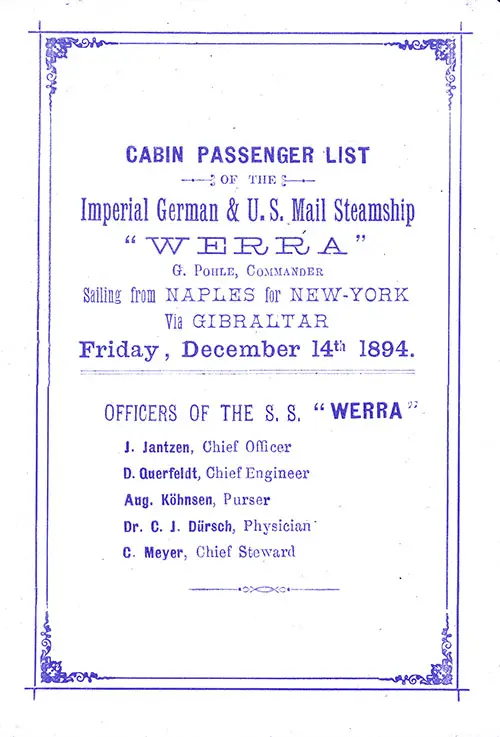
Constructed Title Page with Senior Officers, SS Werra Cabin Passenger List, 14 December 1894. | GGA Image ID # 213dd533b0
Return to Content Links
Back Cover Images
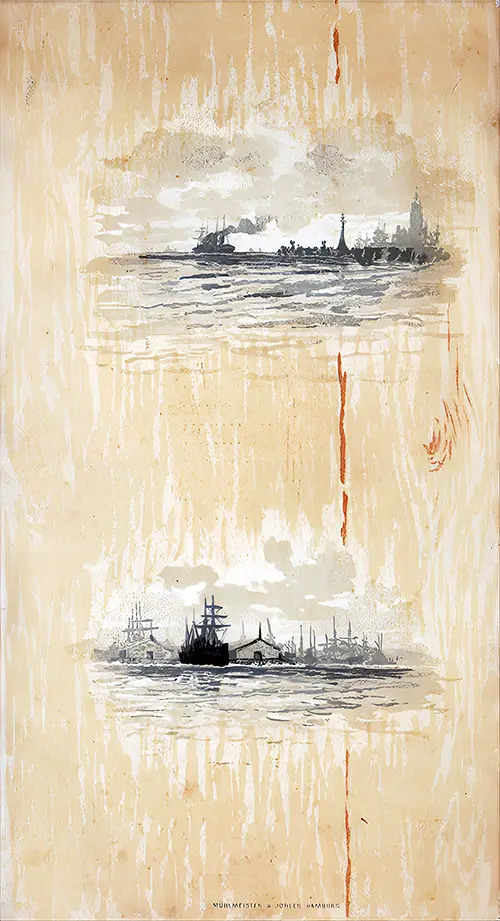
Back Cover, SS Werra Passenger List, 3 May 1890. | GGA Image ID # 1dcbf92ef9
Return to Content Links
Books Referencing the SS Werra

Guide Through North & Central America (Norddeutscher Lloyd) - 1898
🎩 “A Grand Tour by Steamship: Exploring the Americas with North German Lloyd”
Published in April 1898 by J. Reichmann & Cantor of Berlin and New York, the Guide Through North & Central America was more than a simple travel manual. Lavishly illustrated and distributed as a souvenir for passengers aboard North German Lloyd (NDL) steamships, it provided a snapshot of late 19th-century transatlantic tourism, immigration, and shipping excellence.
Intended as a companion piece to NDL’s acclaimed European guide, this first edition introduces readers to the cultural, geographic, and infrastructural wonders of the United States (and parts of Canada and Mexico in future editions). It captured the era of grand steamship travel, a time when visiting Niagara Falls or the Grand Canyon involved weeks of planning and intercontinental coordination.
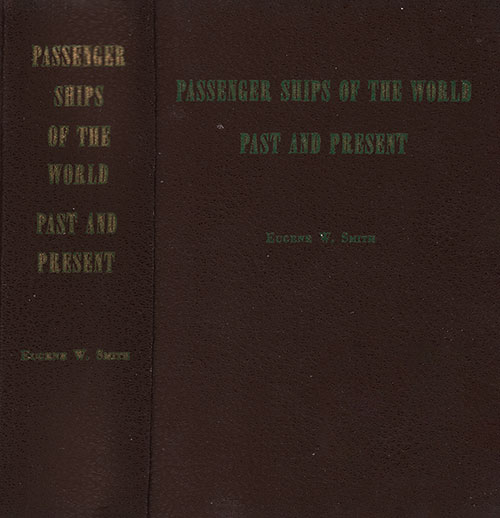
Passenger Ships of the World - 1963
🎓 “A Global Voyage Through Steamship History for Historians, Genealogists, and Maritime Enthusiasts”
Eugene W. Smith’s Passenger Ships of the World – Past and Present (1963) is a masterfully curated encyclopedic reference that charts the rise, peak, and transformation of ocean-going passenger ships through nearly two centuries. Expanding upon his earlier Trans-Atlantic and Trans-Pacific works, Smith offers a global maritime panorama that includes ships serving the Americas, Africa, Europe, Asia, Australia, and Oceania, as well as Canal routes and California-Hawaii shuttle lines.
🧭 This book is an essential resource for:
- Maritime historians seeking design evolution and fleet data
- Genealogists tracing voyages and shipping lines
- Educators and students studying transoceanic migration and tourism
- Ship modelers, naval architects, and enthusiasts interested in dimensions, tonnage, and speed
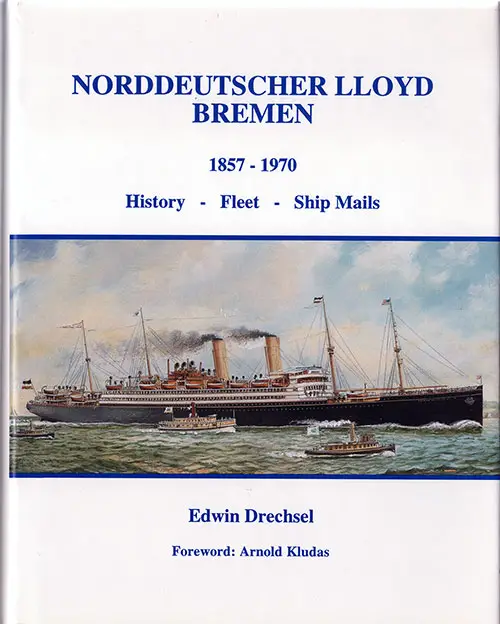
Norddeutscher Lloyd Bremen 1857-1970, Volume One, History -- Fleet -- Ship Mails
🌍 Transatlantic Titans: The Rise of Norddeutscher Lloyd and the Transformation of Ocean Travel (1857–1918)
Norddeutscher Lloyd, Bremen, 1857–1970, Volume 1 by Edwin Drechsel is a meticulously researched chronicle of the origins and golden age of the Norddeutscher Lloyd (NDL), one of the most important steamship lines in global maritime history.
The book covers:
- The founding of NDL in 1857 by Hermann Henrich Meier and Eduard Crüsemann
- The transition from sail to steam, paddle to screw propulsion
- The increasing demand for transatlantic mail and passenger service
- The NDL’s competition with British lines for speed, prestige, and the Blue Riband
- The line’s crucial role in transporting millions of emigrants to North America
- Its involvement in global mail and freight services
- The impact of World War I on German shipping and commerce
Volume 1 concludes just before or during the war years that halted NDL’s rapid rise.

Norddeutscher Lloyd Bremen 1857-1970, Volume Two, History -- Fleet -- Ship Mails
Winds of Change: Norddeutscher Lloyd and the Final Era of Ocean Travel (1920–1970)
The second volume of Edwin Drechsel’s monumental work Norddeutscher Lloyd, Bremen, 1857–1970 picks up in the aftermath of World War I, tracing five tumultuous decades through:
🌊 Postwar decline and slow recovery
🚢 The interwar years and the Blue Riband triumph of the Bremen (1929)
📉 The Great Depression’s toll on ocean travel
🌍 The transformation of global shipping under the shadow of WWII
🧱 Postwar reconstruction and the decline of passenger liners
📦 The pivot to container freight and the 1970 merger with HAPAG
Drechsel, drawing on his personal ties (his father was a North German Lloyd captain), maritime journalism background, and deep expertise in ship mails and German liner history, delivers a book that is both richly detailed and profoundly human.

The American Line: 1871-1902 (2000)
📚 "Restoring the Stars and Stripes to the North Atlantic"
William H. Flayhart III’s The American Line: 1871–1902 is a powerful narrative chronicling one of the most ambitious yet underappreciated efforts in U.S. maritime history: the rebirth of American transatlantic shipping in the age of steam. For teachers, students, historians, genealogists, and lovers of ocean liner history, this book offers an indispensable resource on how the American Merchant Marine tried to reclaim its former glory after the Civil War devastated the industry.
The book centers around the rise of the American Line, backed by Philadelphia’s business elite and the Pennsylvania Railroad, and its close cousin, the Red Star Line, launched under a foreign flag to circumvent U.S. restrictions. Flayhart’s exhaustive research delivers a sweeping yet accessible account of how these two lines changed the face of transatlantic travel.
Return to Content Links
The Fittings of a Passenger Steamer - 1882
The SS Werra, the latest addition to the Atlantic fleet of the North German Lloyd Company of Bremen, has just been completed by Messrs. John Elder & Co. of Fairfield, Govan.
The Chief dining saloon is a very handsome and comfortable apartment, about 40 square feet, lighted by a cupola from the promenade deck.
The style of furniture, cabinet, and upholstery work is of a luxurious description. The main saloon is described as a work of art. The panelings, chiefly walnut, are exceedingly chaste, while the roof is richly carved. All the fittings are gold-plated, while several oil paintings enhance the saloon's beauty.
The "well" in the saloon is 24 feet high from the promenade deck, and much beautiful artistry is shown in it. The sides are of maple, the pannellings being relieved with gold. Several figures painted in oil are introduced, and the design of this portion of the vessel is characterized by taste. In the second-class saloon, the panellings are of maple with gold moldings, while the fittings are of Florentine bronze.
Ventilation and other essential matters in a passenger ship are unusually good. The sleeping cabins for first-class passengers are situated before and above the saloon. They are fitted with every convenience that experience could suggest. The smoking room is on the upper deck, and the ladies' saloon is on the promenade deck.
The latter is an elegant apartment, while the former has several novelties that will no doubt commend themselves to those who frequent it. The second-class accommodation is placed beside the first-class accommodation, and, though plain, it is thoroughly comfortable.
Salvage of the SS Werra in 1886
While the SS Werra (5109 tons gross) was on a voyage from Bremen to New York with 544 passengers and 175 crew members, her machinery- broke down. However, she was still reasonably manageable under sail.
The SS Venetian towed her safely into port, a distance of 1,000 miles, in seven days, the weather being moderately heavy at times. The total value of the Werra, her cargo, and other property on board was about £240,000.
The Court awarded £7,000 and apportioned the amount as follows:—£5,250 to the owners, £583 to the master, and £1,167 to the rest of the crew.
Bibliography
"The Fittings of a Passenger Steamer," in The Furniture Gazette: An Illustrated Weekly Journal Treating of All Branches of Cabinet-Work, Upholstery, and Interior Decoration, London: Wyman & Sons, Printers, Vol. XVIII, 7 October 1882, p. 242.
H. Holman, "Chapter XII Salvage: Towage: Pilotage. (1.) Salvage," in A Handy Book for Shipowners & Masters, 10th Ed., London: William H. Maisey, 1921, p. 276.
Return to Content Links
🌟 Most Engaging Content Highlights
🧳 Passenger Lists (1890, 1894, 1896) – A Human Time Capsule
Each passenger list reveals remarkable social diversity aboard:
🎩 Conte A. L. Rozwadowski, Italian Consul in Chicago (1894) – representing diplomatic ties between Southern Europe and the American Midwest.
✝️ Rev. E. J. Kreidt, Niagara Falls, Canada (1896) – one of several religious leaders crossing for missionary or educational work.
🎶 Director Ed. Strauss, Vienna (1890) – likely the famous Viennese composer-conductor tied to the musical Strauss dynasty, showing how cultural elites embraced ocean liners.
👩👧 Clara Grzybowski and Children, Chicago (1890) – showcasing the familial and migrant narrative of German-American settlement.
🔍 For genealogists, these manifests provide insight into class, profession, origin, and destination, making the Werra a microcosm of global migration trends in the Gilded Age.
📔 Diary of a Voyage on the SS Werra (1894) – A Heartfelt Narrative
A standout addition is the 1894 diary, giving voice to two American women circumnavigating the globe. Their reflections include:
⚓ Farewells at Hoboken and emotional goodbyes.
☀️ Glorious early weather and calm seas.
🎶 A lively deck dance under electric lights.
🌅 Scenic drives through Gibraltar.
🌸 Observations of All Saints' Day in Genoa.
🖋️ Educational Goldmine: This diary, especially when paired with the 1896 passenger list, enriches the historical context for students studying primary sources or teachers designing immersive classroom experiences.
🍽️ Menus (1900) – Cuisine on the High Seas
The luncheon menu of 8 September 1900 features:
🐦 Grilled Pigeons on Toast
🌿 Succotash à L’Anglaise
🥣 Cream Lentil Soup with Frankfort Sausage
🍮 Gmelina Flummery with Raspberry Sauce
🧀 A cold table of cheeses, eel in jelly, Sabbath sausage, anchovies, and more offers a view into Second Cabin dining, reflecting German culinary influence and cosmopolitan tastes.
📚 For culinary historians, this is a flavorful record of early 20th-century maritime dining.
🛏️ Ship Fittings (1882) – Maritime Luxury Meets Function
Detailed from The Furniture Gazette:
🖼️ A richly appointed main saloon with walnut paneling, oil paintings, and a 24-foot-deep well.
🚺 Ladies’ salon with elegant appointments on the promenade deck.
🚬 A smoking room with Florentine bronze fittings.
🛌 Comfortable second-class accommodations adjacent to first-class—rare for its time.
📖 A valuable resource for students of industrial design, architecture, and Victorian interiors.
⚠️ Salvage of the SS Werra (1886) – A Case Study in Maritime Law
Towed 1,000 miles under sail after mechanical failure, the Werra’s salvage operation was awarded £7,000 by the British Admiralty court.
🧭 For legal historians, this event underscores international maritime law and salvage compensation procedures during the late 19th century.
🖼️ Noteworthy Images
📸 SS Werra Approaching Hoboken (ca. 1890)
“The SS Werra (1882)... closing in to their pier at Hoboken, NJ.”
📷 Photo by John S. Johnston, Library of Congress
➡️ Visually anchors the ship’s role in the immigrant experience and Atlantic travel.
📸 Passenger Lists & Officers (1890–1896)
Images of beautifully typeset manifests and staff rosters give insight into the operation and personalities aboard the Werra.
📸 Menu Cover (1900)
Elegant, simple design that reflects the branding of North German Lloyd and appeals to middle-class sensibilities.
📸 Brochure Cover (1889)
A vivid primary source capturing the “Short Route to London” and NDL’s broader marketing strategy during the Paris Exhibition.
📚 Relevance to Researchers, Educators, and the Curious
🎓 For Teachers and Students:
Immigration Studies: A firsthand lens into transatlantic passage before Ellis Island.
Social History: Compare class, gender, and ethnicity aboard a single vessel.
Primary Source Analysis: Diaries, menus, and passage contracts allow multi-dimensional research projects.
🧬 For Genealogists:
🔹 Trace ancestors from Central and Southern Europe through lesser-known Mediterranean routes like Genoa–Gibraltar–New York.
🔹 Understand class and travel conditions tied to manifest entries.
⚓ For Historians and Maritime Enthusiasts:
🔹 Document evolving ship technologies, safety protocols, and prestige marketing.
🔹 Situate NDL’s Werra in a competitive landscape alongside Cunard and White Star.
✍️ Final Thoughts – Why This Archival Collection Matters
The SS Werra Archival Collection at the GG Archives is more than a ship’s record—it’s a narrative of movement, memory, and modernity.
Spanning 1882 to 1933, this collection captures everything from lavish saloons to stranded salvage operations, from diplomatic crossings to immigrant dreams. Whether you're studying German-American migration, tracing a family journey, or analyzing the evolution of international travel—the Werra was there.
⚓ Set sail into the past—start your voyage at the GG Archives today.
